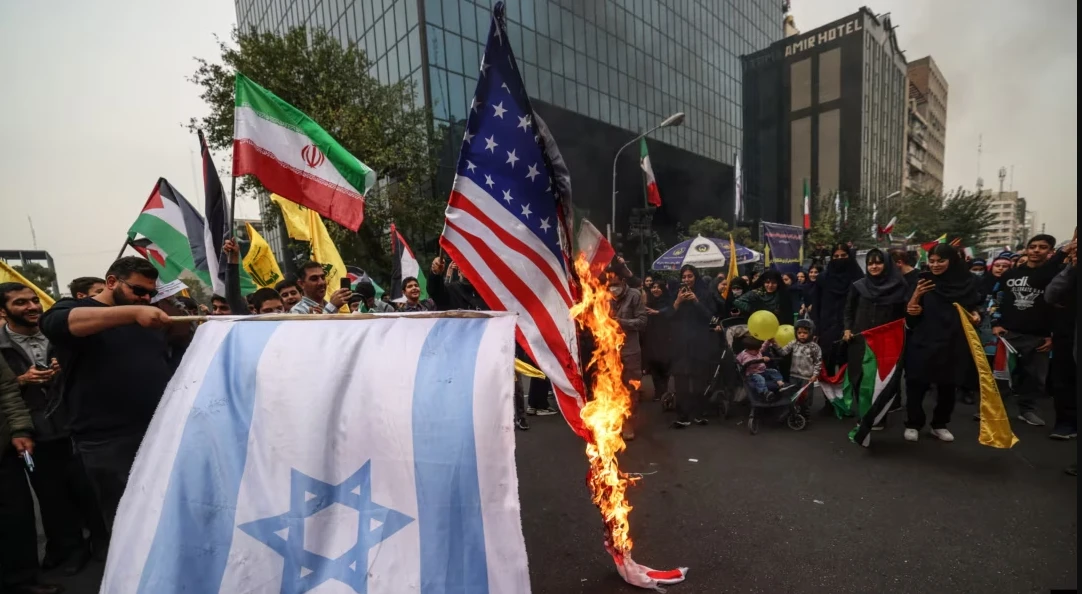Iran's 'axis of resistance': a coalition against Israel, US

Stay tuned with 24 News HD Android App

Iran's "axis of resistance" is spread across several Middle Eastern countries and includes Syria as well as Hamas, Hezbollah and other groups that are united in their opposition to Israel and the United States.
Militant groups in Iraq and Yemen's Huthi rebels are also part of the coalition whose attacks on Israel over the past year culminated in Tuesday's missile barrage from Iran.
Here is the history and motivation behind the grouping that has grown in prominence since October 7 last year, when Hamas's deadly attack on Israel triggered the Gaza war.
Who are they?
The "axis of resistance" is led by Iran, which has steadily cultivated loyalty among states and armed groups around the region since the Islamic revolution of 1979.
The network's membership has gradually expanded over the decades, reaching its largest configuration ahead of the Gaza war.
It includes Lebanon's Hezbollah, the most powerful "axis of resistance" group, operating just across the border from Israel.
Hezbollah, or "Party of God" in Arabic, was founded during the 1975-1990 Lebanon civil war after Israel's 1982 ground assault on Beirut.
Created with the support of Iran's Revolutionary Guards, the group fought Israeli troops who occupied south Lebanon until 2000.
Hamas -- the group behind the October 7 attack against Israel -- has improved its relations with Iran in recent years, gradually becoming a key ally and Iran's main link to the Palestinian territories.
It was created shortly after the first Palestinian intifada (uprising) erupted in 1987, and has ruled the Gaza Strip since 2007.
Yemen's Huthi rebels, who seized the capital in 2014 and have been battling a Saudi-led coalition since 2015, are trained and armed by Tehran.
The rebels, who rule swathes of Yemen including much of its Red Sea coast, staunchly oppose Israel and the United States.
Tehran's regional proxies also include several Iraqi Shiite Muslim groups who emerged from the chaos following the US-led invasion of Iraq in 2003.
The militias have become part of the Iraqi security apparatus and staunchly oppose the presence of US troops in the country.
The Syrian government is the only state actor apart from Iran that is formally part of the axis.
Syria hosts a wide range of Iran-backed militias, including the Fatemiyoun brigade, made up of Afghan recruits, and the Zainebiyoun brigade, drawn from Pakistanis.
Galvanised by Gaza
The Tehran-backed network first functioned as a war-time coalition following the start of the Syrian civil war in 2011, when Iran and Hezbollah intervened to bolster President Bashar al-Assad's forces.
The rise of the Islamic State group in Iraq and Syria in 2014 also saw Iran and Hezbollah back militias in both countries as part of an anti-jihadist coalition.
The Gaza war cemented a coordinated strategy that they dubbed the "unity of fronts", which is designed to ring Israel with attacks from several countries.
Hezbollah has traded fire with Israel on a near daily basis since last year, with the conflict now eclipsing the Gaza war as Israel steps up its attacks.
The Huthis have launched several missiles towards Israel and have been harassing Israel-linked shipping off Yemen's coasts since November.
Iraq's Shiite paramilitary groups have formed a loose alliance known as the Islamic Resistance of Iraq since the start of the Gaza war.
The alliance has claimed to have targeted Israel with drones and rockets, sometimes in joint operations with Yemeni rebels.
Iran has launched two direct missile attacks against Israel -- the first in April and the second on Tuesday.
Pro-Iran, anti-imperialist
Iranian support is one of the main elements that feeds the network and binds it together.
"The military and security echelons of power in Iran serve as the logistical and organisational supply chain for the axis," said Arshin Adib-Moghaddam, a professor at London's School of Oriental and African Studies.
According to Hezbollah expert Amal Saad, the "axis of resistance" also shares a common political ideology.
"The raison d'etre of the axis of resistance has always been resisting Israel and US hegemony" in the region, said Saad, who is also a lecturer in politics at Cardiff University.
While the axis is often couched in Shiite Islamist ideology espoused by Tehran and Hezbollah, its members also include the secular Baathist government in Syria as well as Hamas, a Sunni militant group, said Saad.
"They share an identity and discourse which is anti-imperialist and anti-Zionist," Saad said.
"This is an actual solid, ideological, political alliance, but it's also active in wartime," she added.
"It's an unprecedented alliance -- the first in history that consists of state and non-state actors but in which non-state actors are doing most of the fighting."
Their shared objective of dismantling Israel is not purely ideological but is also based on threats to their own security from Israel and its backers, according to Saad.
